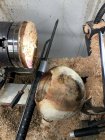I recently attended an Ellsworth demo. I was inspired to try and complete a hollow form like he did. Turned a log to a sphere then rotated the pith to the side. I made it to point where I thought it would be ok. However when I removed the form from the chuck there was far to much mass in the walls and I re mounted and began to thin the walls again.
As you can see in the photos I took out too much material from the transition point and that was the end of it. What’s your procedure for avoiding this and checking overall wall thickness?
On a side note, David completed his form in seemingly minutes and with such ease. I realize he is a master at his craft but he made it look deceivingly easy!
As you can see in the photos I took out too much material from the transition point and that was the end of it. What’s your procedure for avoiding this and checking overall wall thickness?
On a side note, David completed his form in seemingly minutes and with such ease. I realize he is a master at his craft but he made it look deceivingly easy!


